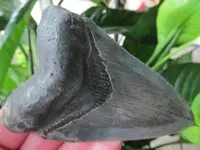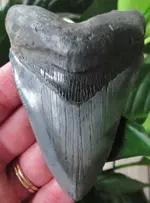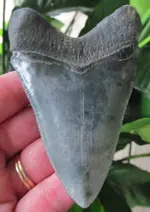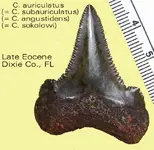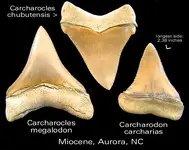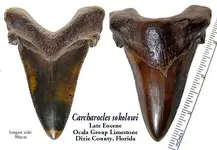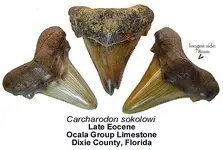You are using an out of date browser. It may not display this or other websites correctly.
You should upgrade or use an alternative browser.
You should upgrade or use an alternative browser.
Tooth : Megalodon or Subauriculatus
- Thread starter oldfossil
- Start date
Age_old
Sr. Member
- Joined
- Jul 30, 2012
- Messages
- 316
- Reaction score
- 63
- Golden Thread
- 0
- Location
- Clearwater, Florida
- Detector(s) used
- Bounty Hunter
- Primary Interest:
- All Treasure Hunting
That's a Meg for sure! And a fantastic one at that! Was it a personal find? 

oldfossil
Tenderfoot
- Joined
- Jul 25, 2013
- Messages
- 7
- Reaction score
- 0
- Golden Thread
- 0
- Primary Interest:
- All Treasure Hunting
- #3
Thread Owner
Thank you Sam. I bought this tooth actually, which I understand was found at the South Carolina River. As I am new to fossil tooth collecting, I was concerned when I read that the tooth of the C. Subauriculatus has the two little cusps located at each side where the root meets the blade. Mine seem to have those. I bought it as a Meg tooth.
Harry Pristis
Bronze Member
- Joined
- Feb 5, 2009
- Messages
- 2,353
- Reaction score
- 1,297
- Golden Thread
- 0
- Location
- Northcentral Florida
Harry Pristis
Bronze Member
- Joined
- Feb 5, 2009
- Messages
- 2,353
- Reaction score
- 1,297
- Golden Thread
- 0
- Location
- Northcentral Florida
Thank you for the clarification. The pictures you showed definitely helped! Below is the picture I saw that caused my "confusion".
I can see how 'FossilGuy's image might confuse you. His tooth is not even close to the C. subauriculatus we find in Florida in the Late Eocene Ocala Group Limestone.
Richard Hulbert (Ed.) in his THE FOSSIL VERTEBRATES OF FLORIDA (2001) sums up the situation with megatooth sharks as well as anyone. He points to research that says that the type specimen originally labeled as Carcharodon auriculatus is actually another species, C. subauriculatus.
Depending on which authors you go with, C. subauriculatus is synonymous with C. angustidens or C. sokolowi. Hulbert favors sokolowi, following Case and Cappetta (1990).
Sooo . . . Florida auriculatus teeth apparently are something else, but it is not certain yet (2001) which is the correct species name under the Rules of Nomenclature, pending more study of morphology. And, I wouldn't be surprised if some other reorganization appears. There are eleven mega anna between the Oligocene Chandler Bridge Fm and the Late Eocene Crystal River Fm (Ocala Group).
If you wish to adopt the Hulbert-Case-Cappetta species name, Carcharodon sokolowi, I believe that it is acceptably pronounced SO-KO-LAW-VAYE, recognizing a Russian taxonomist named Sokolov.
oldfossil
Tenderfoot
- Joined
- Jul 25, 2013
- Messages
- 7
- Reaction score
- 0
- Golden Thread
- 0
- Primary Interest:
- All Treasure Hunting
- #8
Thread Owner
I can see how 'FossilGuy's image might confuse you. His tooth is not even close to the C. subauriculatus we find in Florida in the Late Eocene Ocala Group Limestone.....
Thank you Harry. That's very interesting information indeed. So the cusps or "ears" need to be more prominent to qualify as C. Subauriculatus, C. Angustidens or C. Sokolowi. Looks like I've got a lot more research and reading to do! And you have pointed me in the right direction, which I am grateful.
oldfossil
Tenderfoot
- Joined
- Jul 25, 2013
- Messages
- 7
- Reaction score
- 0
- Golden Thread
- 0
- Primary Interest:
- All Treasure Hunting
- #10
Thread Owner
Harry, I had a bit of time over the weekend and tried doing more research. I found www.megalodonsharkteeth.com. And I saw their photos of C Chubutensis. Most of them sure look a lot like mine, with subtle "ears". Attaching a few of them from the Chubutensis section. Truly beautiful specimen!








Harry Pristis
Bronze Member
- Joined
- Feb 5, 2009
- Messages
- 2,353
- Reaction score
- 1,297
- Golden Thread
- 0
- Location
- Northcentral Florida
Using commercial sites for identification purposes is often misleading. These don't appear to be anything other than C. megalodon. Go to elasmo.com
oldfossil
Tenderfoot
- Joined
- Jul 25, 2013
- Messages
- 7
- Reaction score
- 0
- Golden Thread
- 0
- Primary Interest:
- All Treasure Hunting
- #12
Thread Owner
Using commercial sites for identification purposes is often misleading. These don't appear to be anything other than C. megalodon. Go to elasmo.com
Thanks Harry. That's a good reference website. For C Chubutensis, it says "Lateral cusplets are evident but not spectacularly prominent." Its clearer to me now.


Similar threads
- Replies
- 14
- Views
- 2K
- Replies
- 4
- Views
- 272
Users who are viewing this thread
Total: 1 (members: 0, guests: 1)


